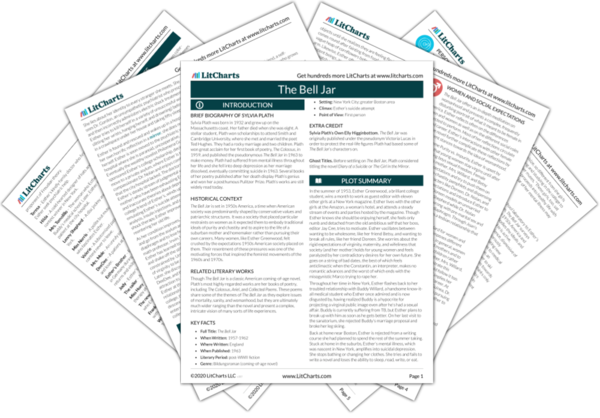Summary
Analysis
Esther Greenwood begins her reminiscence of the summer of 1953 when she won a contest to live in New York for a month as the guest editor of a fashion magazine. Though Esther knows she should feel accomplished and grateful for the opportunity to work in New York, she instead feels numb and detached from her own life. She is obsessed with the electrocution of the Rosenbergs (a married couple executed for being Soviet spies). She feels all her college achievements have “fizzled to nothing” in New York and that she is “very still and very empty, the way the eye of a tornado must feel.”
Esther introduces herself as a person in flux, no longer able to enjoy the fruits of her old ambitions (like her college achievements) or to value what society expects her to value (like the opportunity to spend a summer working in New York). The metaphor of the tornado is at once an image of stable purity (a still, empty center) and an image of filth and chaos (the swirling dust and matter the tornado swirls around that center).
Themes
Esther lives with the eleven other contest winners in the Amazon, a women-only hotel otherwise inhabited mostly by wealthy girls Esther’s age working as secretaries in New York while they wait to get married. Her best friend among the other contest winners is Doreen, a cynical, witty, sexy rule-breaker who tries to talk Esther out of doing her work for Jay Cee, her boss at the fashion magazine. Betsy, a wholesome, all-American girl from Kansas, continually invites Esther to hang out with her and the other girls “as if she were trying to save me in some way,” Esther reflects.
Women-only hotels were popular in the 1950s as places to house young, unmarried women. Separating themselves from men was a way for these young women (and the women’s parents) to protect their purity/virginity. Doreen and Betsy embody two contrasting models of womanhood: Doreen represents sexual experience and rebelliousness while Betsy represents innocence and obedience.
Themes
For a magazine-hosted party tonight, Esther rejects Betsy’s offer to share a cab in order to go with Doreen, who says they’ll just go for a little while before heading “out on the town.” Doreen criticizes all the young Yale men she expects will be at the party. “They’re so stoo-pit!” she says. Esther reflects, “Buddy Willard went to Yale, but now that I thought of it, what was wrong with him was that he was stupid,” in spite of his good grades. Esther hears what Doreen says “like a secret voice speaking straight out of my own bones.”
Esther is attracted to Doreen and the cynical worldliness Doreen embodies through her witty snark and adventurousness. Doreen also offers Esther a new way of measuring achievement. Though Esther has always thought that Buddy was smart because he got good grades and went to Yale, Doreen makes her realize that academia is not the only metric of intelligence.
Themes
In a cab stuck in traffic on the way to the party, Esther and Doreen are approached by the dapper, smiling, disc jockey Lenny Shepherd, who convinces the girls to abandon the cab and join him and his friends in a bar. Esther, with her yellowing tan, skinny figure, and unbecoming dress, knows that Lenny is attracted to Doreen’s voluptuous beauty, but she is excited to see another side of city life and doesn’t care. Indeed, Lenny immediately pawns Esther off on his squat, squeaky-voiced friend Frankie in order to dote on Doreen.
The first of many moments illustrating social expectations about women’s bodies: Esther’s thin boyish physique is considered less attractive than Doreen’s blonde voluptuousness. However, Esther ignores these social expectations in favor of her own system of value: instead of romance and male attention, she is looking for new knowledge and experiences.
Themes
Get the entire The Bell Jar LitChart as a printable PDF.

Sitting in the bar, Esther thinks, “I felt myself melting into the shadows like the negative of a person I’d never seen before in my life.” She orders straight vodka to avoid exposing her ignorance about cocktails, and because she remembers an ad in which vodka “looked clear and pure as water.” Drinking it, she finds it tasteless but feels it makes her “powerful and god-like.” She tells Lenny and Frankie that her name is Elly Higginbottom and she’s from Chicago, so as not to have “anything I said or did that night…associated with me and my real name and coming from Boston.” Lenny tries to get Doreen to come home with him and Doreen says she won’t go without “Elly.” Esther says she’ll go too and thinks she “liked looking at other people in crucial situations,” like “a road accident or a street fight or a baby pickled in a laboratory jar.”
As with Esther’s opening comparison of herself to a tornado’s eye, the metaphor of being a negative of a stranger dematerializes her body, sapping it of stable heft. In a similar fashion, giving the fake name and identity ‘Elly Higginbottom from Boston’ makes ‘Esther Greenwood from Chicago’ seem to disappear. Esther’s attraction to vodka’s clearness introduces her obsession with purity and her frequent equation of physical pureness with spiritual transcendence (as when the vodka makes her feel ‘god-like’).
Themes












